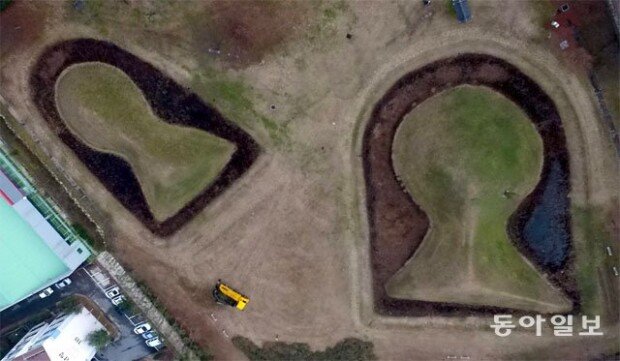'Tombs in southern part house Japanese soldiers,' says professor
'Tombs in southern part house Japanese soldiers,' says professor
Posted April. 11, 2018 07:45,
Updated April. 11, 2018 07:45

“Who are the owners of the Japanese-style tombs discovered in the southern part of the country?”
Keyhole shaped tombs discovered in Wolgye-dong, Gwangju City are quite different from Korean traditional ancient tombs. As the name suggests, the tombs are shaped like a keyhole with its front part of a trapezoid and the back part forming a circle. They are typical Japanese style tombs during the Kofun Period between the 3rd century and 7th century.
Recently, it has been argued that the owners of the Japanese-style tombs on the Korean Peninsula are Japanese mercenary soldiers, who came to Baekje from Japan in the 5th century. Park Cheon-soo, professor of Archaeological Anthropology at Kyungpook National University, suggested the possibility in his recently-released thesis “Baekje and Japan: Looking from Japanese-Style Tombs.”
“Judging from the relics excavated from the tombs and the analysis of ancient documents, such as The Chronicles of the Three States and Nihon Shoki, it is reasonable to assume that the owners of the tombs are not Japanese ruling class but lower class Japanese soldiers,” Professor Park said. “They are the proof that unlike some Japanese scholars’ argument, Japan did not dominate Baekje, Silla, and Gaya in the 4th century.
According to ancient documents, Japanese soldiers came to the Korean Peninsula around 405. It is written in The Chronicles of the Three States and Nihon Shoki that “When his dad King Ashin died, Baekje Prince Jeonji came back to Baekje under convoy of 100 Japanese soldiers.” There are no records on Japanese soldiers afterwards. But it is written on the tombstone of King Gwanggaeto the Great that “Japan attacked with ships,” which suggests that the Japanese soldiers participated in the war between Baekje and Goguryeo.
“The surface of the Andong and Yamak tombs located in Goheung County, South Jeolla Province is covered with rocks and Japanese-style swords and armors were excavated from them. This tells us that the owners of the tombs are Japanese,” Park said. “The fact that the tombs are situated in strategic points and gilt bronze crown, which appears to be bestowed from the royal family, was found inside the tombs raises the possibility that the owners of the tombs served as mercenary soldiers of Baekje.”
As is the case with King Jeonji, King Dongseong of Baekje came back to his country escorted by 500 Japanese soldiers after his father King Samgeun died in 479. The tombs found near the Yeongsan River are believed to have housed these 500 Japanese soldiers in the early 6th century. These tombs resemble the tunnel-tombs in Kyushu, Japan. In addition, gilt glasses, which the royal family of Baekje had used, were found inside the tombs.
Some Japanese scholars have insisted on their theory that Japan dominated Baekje, Silla and Gaya in the 4th century on the basis of these tombs. “These tombs do not have a regular form. They mostly appeared during the 5th and 6th centuries and disappeared altogether afterwards,” said Professor Park refuting Japanese scholars’ argument. “This is why the owners of the tombs are not Japanese ruling class, who dominated countries on the Korean Peninsula, but Japanese soldiers, who temporarily lived here.”
Won-Mo Yu onemore@donga.com







